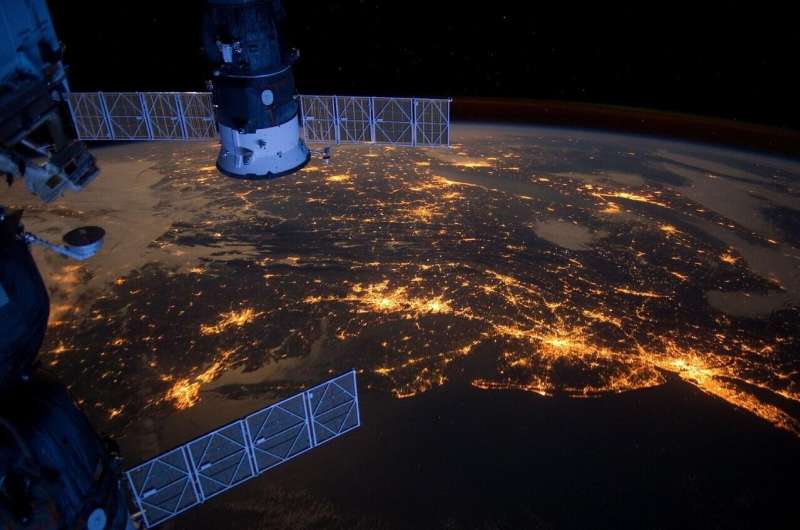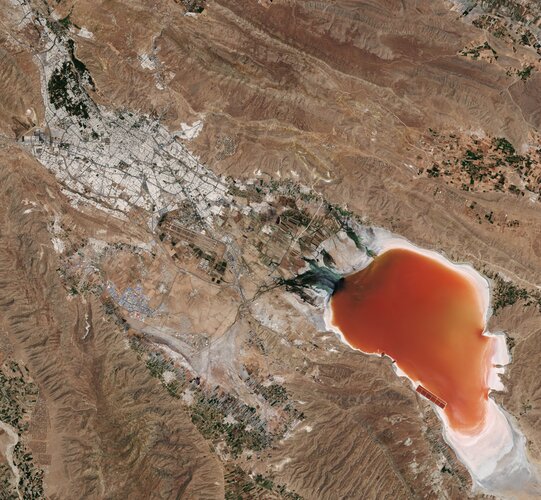
Copernical Team
Inspiration4 civilian mission plans splashdown Saturday evening
 The crew of the first all-civilian orbital space mission, Inspiration4, plans to splash down off the coast of Florida on Saturday evening.
SpaceX plans a 7:06 p.m. EDT return to Earth, but hasn't announced the exact location. That will depend on weather and wave heights in the Gulf of Mexico and Atlantic Ocean.
"We're seeing the world every 90 minutes. That's how fast we're trave
The crew of the first all-civilian orbital space mission, Inspiration4, plans to splash down off the coast of Florida on Saturday evening.
SpaceX plans a 7:06 p.m. EDT return to Earth, but hasn't announced the exact location. That will depend on weather and wave heights in the Gulf of Mexico and Atlantic Ocean.
"We're seeing the world every 90 minutes. That's how fast we're trave SpaceX tourists talk to Tom Cruise from orbit, provide update on flight
 Four space tourists orbiting the Earth in a SpaceX capsule at 17,500 miles per hour (28,162 kph) talked to movie star Tom Cruise on Friday and provided a live update about life aboard the spacecraft.
The first space tourism mission by Elon Musk's SpaceX blasted off from Florida on Wednesday for a three-day voyage that is to end with a splashdown in the Atlantic Ocean at 4:06 pm Pacific time
Four space tourists orbiting the Earth in a SpaceX capsule at 17,500 miles per hour (28,162 kph) talked to movie star Tom Cruise on Friday and provided a live update about life aboard the spacecraft.
The first space tourism mission by Elon Musk's SpaceX blasted off from Florida on Wednesday for a three-day voyage that is to end with a splashdown in the Atlantic Ocean at 4:06 pm Pacific time What life is like aboard the SpaceX Dragon capsule
 The first space tourism mission by Elon Musk's SpaceX blasted off from Florida on Wednesday and the four crew members - a billionaire and three other Americans - have already seen more than 25 sunsets and sunrises.
SpaceX has released few details about their adventure since they reached an orbit which is more distant than that of the International Space Station.
Here's what we know abo
The first space tourism mission by Elon Musk's SpaceX blasted off from Florida on Wednesday and the four crew members - a billionaire and three other Americans - have already seen more than 25 sunsets and sunrises.
SpaceX has released few details about their adventure since they reached an orbit which is more distant than that of the International Space Station.
Here's what we know abo ABL Space selected for NASA Cryogenic Demonstration Mission
 ABL Space Systems announced that is has been selected as the launch provider for the NASA Cryogenic Demonstration Mission. Developed under a NASA Tipping Point contract awarded in 2020, the Cryogenic Demonstration Mission will launch in 2023 and demonstrate in-space transfer of cryogenic liquid hydrogen (LH2), the most challenging but highest-performing propellant for lunar and deep space explor
ABL Space Systems announced that is has been selected as the launch provider for the NASA Cryogenic Demonstration Mission. Developed under a NASA Tipping Point contract awarded in 2020, the Cryogenic Demonstration Mission will launch in 2023 and demonstrate in-space transfer of cryogenic liquid hydrogen (LH2), the most challenging but highest-performing propellant for lunar and deep space explor SKorea plans to launch solid-propellant space launch vehicle in 2024, Defence Ministry says
 South Korea's Institute for Defense Analyses managed to carry out successful firing tests of a solid-propellant engine for a new space launch vehicle already on 29 July, paving way for commercial launches of this type of rockets to start as early as in 2024, the defense ministry said on 16 September.
The new engine will allow launching small satellites and groups of extra-small satellites
South Korea's Institute for Defense Analyses managed to carry out successful firing tests of a solid-propellant engine for a new space launch vehicle already on 29 July, paving way for commercial launches of this type of rockets to start as early as in 2024, the defense ministry said on 16 September.
The new engine will allow launching small satellites and groups of extra-small satellites SpaceX Inspiration4 mission sent 4 people with minimal training into orbit
 Just after 8 p.m. EST on Sept. 15, 2021, the next batch of space tourists lifted off aboard a SpaceX rocket. Organized and funded by entrepreneur Jared Isaacman, the Inspiration4 mission touts itself as "the first all-civilian mission to orbit" and represents a new type of space tourism.
The four crew members are not the first space tourists this year. In the past few months, the world wit
Just after 8 p.m. EST on Sept. 15, 2021, the next batch of space tourists lifted off aboard a SpaceX rocket. Organized and funded by entrepreneur Jared Isaacman, the Inspiration4 mission touts itself as "the first all-civilian mission to orbit" and represents a new type of space tourism.
The four crew members are not the first space tourists this year. In the past few months, the world wit Soundblasting a satellite: Time-lapse of testing

Verifying that a satellite will resist the sheer noise of the rocket launching it into orbit is a very important test that every mission must successfully pass.
"Typically satellites are tested inside purpose-built reverberant chambers, such as ESTEC's own Large European Acoustic Facility sometimes described as the largest and most powerful sound system in Europe," explains ESA test facility expert Steffen Scharfenberg, overseeing the test campaign together with ESA mechanical engineer Ivan Ngan. A very powerful noise generation system produces a uniform noise field thanks to the reverberation on the thick concrete walls of the chamber.
ESA has initiated a working group comprising of European spacecraft testing entities, industries and academics to study an alternative method, in which the satellite is surrounded by less powerful noise generators but these are placed very close all around the satellite. This method is called the Direct Field Acoustic Noise Test.
This technique is already in use in several locations but there is not yet much experience of it in Europe. Accordingly ESA has just completed a test campaign where the classic method and the new method have been used on a small satellite to compare their results.
Back to School with ESA astronaut Matthias Maurer
 Video:
00:04:32
Video:
00:04:32
Kick off the 2021-22 school year with ESA school projects. ESA astronaut Matthias Maurer introduces the wide range of space-based STEM projects available to primary and secondary students: Moon Camp, Climate Detectives, Astro Pi, CanSat and Mission X.
Week in images: 13 - 17 September 2021

Week in images: 13 - 17 September 2021
Discover our week through the lens
Earth from Space: Maharloo Lake

Maharloo Lake, a seasonal salt lake in Iran, is featured in this image captured by the Copernicus Sentinel-2 mission.
